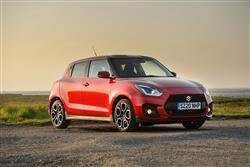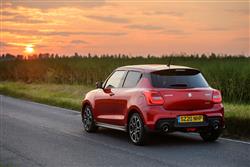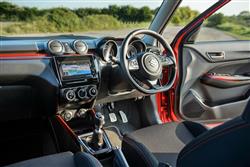Suzuki Swift Sport Hybrid - ABC Leasing
How will you view?
This is a sample, showing 30 seconds of each section.
A JOLLY GOOD SPORT(some text hidden)
By Jonathan Crouch
Ten Second Review word count: 86
The Suzuki Swift Sport has long been a car embraced by serious drivers who know a great handling hot hatch when they see it and remains so in this improved third generation form. Though not especially powerful, it's agile, chuckable and brilliant fun for not a lot of money. Now, its 1.4-litre Boosterjet turbo engine has gained mild hybrid assistance, which has enhanced torque, efficiency and in-gear acceleration. This car will still be a well-kept secret in this segment, but one loyal buyers will enjoy hugely.
Background word count: 128
I remember when Hot Hatches weren't all about power. You had a simple, revvy, normally aspirated engine and there was certainly no need to fuss about with extra go-faster gadgetry. Four-wheel drive, trick diffs, double-clutch gearboxes, electronic stability systems - all very nice but all there to add weight and cost to what ought to be a simple, inexpensive formula. You might think that it's too late to turn the clock back in this segment - but Suzuki doesn't, delivering us this car, the third generation Swift Sport, here enhanced with mild hybrid power. This car remains one that can routinely put the wind up far more exalted machinery but and sits in the warm hatch sector somewhere between the Volkswagen up! GTI and the Ford Fiesta ST.
Driving Experience word count: 285
The Swift Sport has never been about pure power. Suzuki could easily shoehorn a 200bhp engine into the thing if it pleased, but that would just make it uninsurable for younger drivers. Instead, and rather sensibly, the engine power output of this model has always been modest. For years, this Swift Sport campaigned with a normnally aspirated 1.6 with 134bhp, replaced at this third generation model's launch in 2017 by a 1.4 Boosterjet turbo unit offering 138bhp. This Hybrid model uses an updated 'K14D'-series version of the same Boosterjet engine with 127bhp and that (plus a bit of extra weight) explains why the rest to 62mph sprint time has fallen by a second to 9.1s, though the top speed remains at 130mph. The eagerness of the original MK3 model remains though, partly because the mild hybrid unit has the ability to 'torque-fill' under acceleration to compensate for turbo lag. And partly because pulling power has actually risen slightly - up from 230 to 235Nm. Otherwise, the appealing recipe that charmed us with this car back in 2017 remains much as before. Suzuki's emphasis on chassis dynamics for this third generation car serves up impressive levels of poise and control, aided by a bespoke suspension design that offers driving stability, optimized roll rigidity and a surprisingly high degree of dynamic response. It's all bolted to the same particularly stiff, light 'HEARTECT' platform that underpins the ordinary Swift model. There's a total kerb weight of 1,025kgs, which is 55kgs heavier than the pre-Hybrid model but that still undercuts most warm hatch rivals. Which is why this Suzuki can match the real world performance of its direct competitors, despite offering considerably less power. Have cake; eat it. Simple.
Pictures (High res disabled)

.jpg)
.jpg)
.jpg)
.jpg)
.jpg)


Scoring
Category: Compact Car
| Performance | |
| Handling | |
| Comfort | |
| Space | |
| Styling | |
| Build | |
| Value | |
| Equipment | |
| Economy | 80% |
| Depreciation | 70% |
| Insurance | 70% |
| Total | 74% |